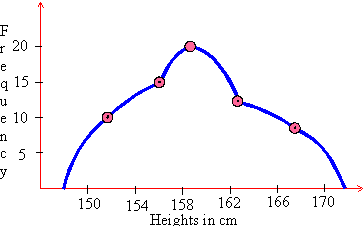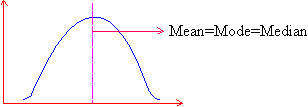|
3) Frequency Distribution (Curve):- Frequency
distribution curves are like frequency polygons. In frequency distribution,
instead of using straight line segments, a smooth curve is used
to connect the points. The frequency curve for the above data is
shown as:

Shape of Distribution Curves:- We have seen
what a distribution curve looks like. There are four types of distribution
curves. (i) Symmetrical or bell-shaped (ii) Moderately symmetrical
or skew (ii) J-shaped and (iv) U-shaped. We shall only study the
first two.
i) Symmetrical distribution:- As the name suggests,
if the distribution is symmetrical, the curve rises gradually, reaches
a maximum then falls equally gradually. The curve looks like a bell.
This curve is symmetrical about the maximum frequency. For a perfectly
symmetrical distribution, the mean, the mode and the median all
coincide. This curve displays perfect symmetry, that is, its left
half is the mirror image of the other right half. A bell-shaped
or mound-shaped curve is also known as the normal curve, giving
it special properties. This is an ideal situation and therefore,
rarely found in practice.

ii) Moderately symmetrical or Skew:- The
curve is symmetrical but only moderately. If it rises rapidly, reaches
a maximum and then falls slowly, it is a called a positively skewed
curve. If it rises slowly, reaches a maximum and then falls rapidly,
it is called a "negatively skewed curve". For these curves; the
mean, the median and the mode do not coincide. In much of the economic
and social phenomenon, we come across such curves.

|
Index
3.1 Introduction
3.2 Comparison Between Tabular And Diagrammatic
Presentation
3.3 Difference Between Diagrams And Graphs
3.4 General Principles Of Constructing Diagrams
3.5 Bar Diagrams
3.6 Pie Chart
3.7 Graphs
3.8 Box and Whiskers
Chapter 4
|